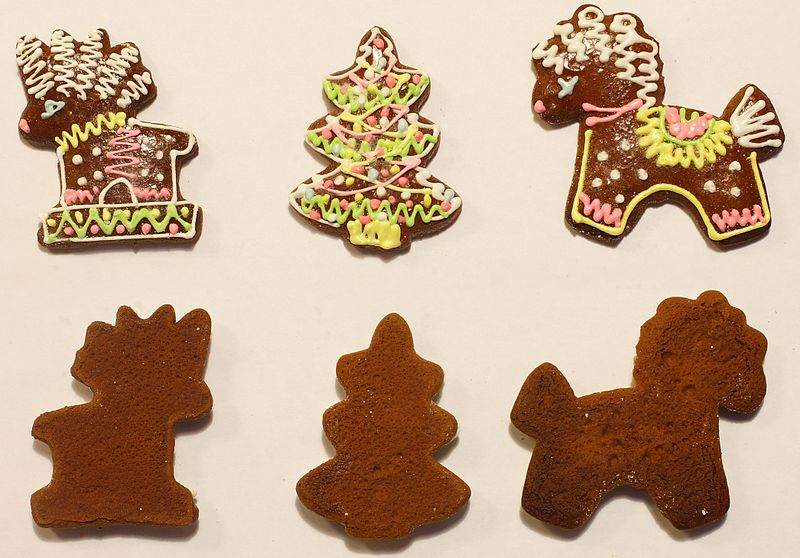Fíoracha Sinséir – How to Say ‘Gingerbread Men and Women’ in Irish Posted by róislín on Dec 26, 2014 in Irish Language

Fíoracha Sinséir Nach Fir ná Mná Iad–Céard Iad na Cruthanna Atá Anseo? Freagra ag bun an bhlag (And the original captions, with the Irish added here:
Irish: Kozuli, cineál aráin sinséir ó Arkhangelsk
English: Kozuli, the type of Arkhangelsk’s gingerbreads.
Français : Trois Kozuli, un type de pain d’épice provenant d’Arkhangelsk.
Русский: Козули, вид архангельских пряников. (Lvova Anastasiya, http://commons.wikimedia.org/wiki/File:Three_kozuli.jpg)
(le Róislín) We recently looked at one type of arán (bread), with a recipe in Irish (naisc thíos do na blaganna faoi arán sóide agus Leabhar Cócaireachta Transparent Language).
Today, to be seasonal, let’s look at another type of bread, “arán sinséir” (gingerbread).
As usual, let’s start with the basics, first the word for “ginger” (the spice, not the hair color, which would be “rua,” a completely different word)
sinséar [SHIN-shayr] ginger
This word changes to “sinséir” [SHIN-shayrzh] when it is used to describe things of, made of, or at least partly made of ginger, as in:
féar sinséir, ginger-grass (note the síneadh fada over the “e” in “féar” — otherwise it would mean “gingerbread man” since the Irish for “man” is “fear” (rhyming more or less with the first syllable of “Carol” or “barrel” — don’t let the spelling mislead you!)
meireang sinséir, ginger meringue
mús sinséir, ginger mousse
And that brings us to one of our key phrases for today: arán sinséir [uh-RAWN SHIN- shayrzh], gingerbread. Remember, if you want to say, “the gingerbread,” you add the “t-” prefix: an t-arán sinséir, the gingerbread
I’ve hunted around online to see what references I can find in Irish to gingerbread houses and gingerbread men (and women). In general, I have to say there’s not a whole lot out there, but I do note, in the handful of references available, that “gingerbread house” seems to include the word “bread” but that the figures of men and women do not. There’s no apparent reason, just “traidisiún,” I suppose.
So “gingerbread house” would be “teach aráin sinséir,” with the plural “tithe aráin sinséir.” Both of those phrases happen to have look-alike English words, so just a brief reminder here:
teach [tchakh], house, with the “ch” like German “Buch,” Welsh “bach” or Scottish/Irish English “loch”. Nothing like the English “teach.”
tithe [TCHIH-huh, with the second “t” silent], houses. Nothing like the English “to tithe.”
As for the figure shapes, almost all the references I see in a culinary context simply refer to them as “figures” (fíoracha), not “men” or “women.” Of course, one can translate the phrase “fíor sinséir” as “gingerbread man” but technically the first word is “fíor” (figure), not “fear” (man). So we have:
fíor sinséir [feer SHIN- shayrzh], gingerbread man/figure
an fhíor sinséir [un eer SHIN- shayrzh], the gingerbread man/figure
fíoracha sinséir [FEER-uh-khuh SHIN- shayrzh], gingerbread men/figures
na fíoracha sinséir, the gingerbread men/figures.
If you do want to specify “man” and “woman,” you can say the following, which I see used in the context of the children’s story:
fear sinséir, lit. man of ginger
an fear sinséir, lit. the man of ginger
As for the female version, I see almost no references, but we could say:
bean sinséir, lit. woman of ginger
an bhean sinséir, lit. the woman of ginger
It has always intrigued me that none of the references I see for these gingerbread “figures” (or men or women) actually use the Irish word for “bread” in the translation. These are all “ginger” figures, men, etc. Maybe adding the word “bread” seems to make the phrase too long?
Anyway, I suppose if one chose to take some whole ginger root (aka “root ginger”!) and carve it into a figure, that would also be a “fíor sinséir” or a “fear sinséir,” etc. Unless you got a bit complicated and said “fíor déanta as fréamh sinséir” (OR: fíor déanta as sinséar fréimhe).
And that’s some of the technicalities of the phrases. Meanwhile, I hope that especially at this festive time of year, you’ve been able to enjoy some “fíoracha sinséir,” b’fhéidir le rísíní mar chnaipí agus beagán reoáin chun línte éadaí na bhfíoracha a thaispeáint. Agus is breá liom blas an mholáis chomh maith le blas an tsinséir. Neam! SGF – Róislín
Freagraí: Na Cruthanna — réinfhia, crann, capall
Naisc:
Oideas i nGaeilge: Arán Sóide Éireannach, agus Aistriúchán Béarla (and an English translation) Posted on 11. Dec, 2014 by róislín in Irish Language (https://blogs.transparent.com/irish/oideas-i-ngaeilge-aran-soide-eireannach-agus-aistriuchan-bearla-and-an-english-translation/)
Gluais don Oideas “Arán Sóide” (A Glossary for the Irish Soda Bread Recipe, with pronunciation guide) Posted on 15. Dec, 2014 by róislín in Irish Language https://blogs.transparent.com/irish/gluais-don-oideas-aran-soide-a-glossary-for-the-irish-soda-bread-recipe-with-pronunciation-guide/
Around the World in 17 Recipes: 17 Mouth-Watering, Multi-Cultural Recipes to Bring the World into Your Kitchen (http://www.transparent.com/ebooks/around-the-world-in-17-recipes.html)

Build vocabulary, practice pronunciation, and more with Transparent Language Online. Available anytime, anywhere, on any device.




Leave a comment: